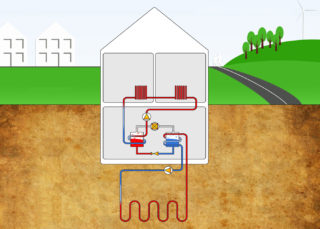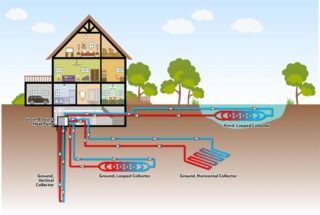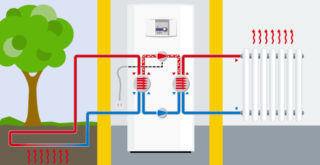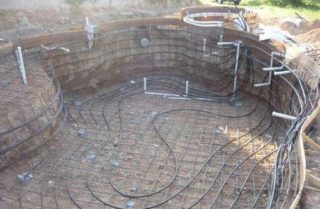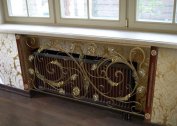Geothermal heating at home is a promising alternative energy generation technology, designed for a payback period of several years. Constantly rising utility costs are forcing private property owners to look for new and unconventional ways to save energy. The problem can be solved using the geothermal heat of the earth. You can make such a system yourself, thereby saving a lot on the services of professionals. It is enough to study the technology of ground heating, draw up a competent diagram, purchase equipment and complete its installation.
Features of geothermal heating
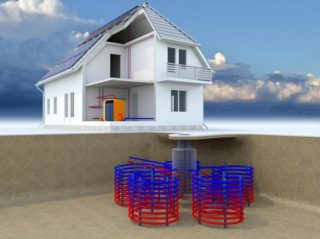
A geothermal heating system is a semi-autonomous installation that works from two energy sources:
- The potential energy of the earth. Its temperature at depth is almost stable, regardless of weather and season.
- Electricity. It is necessary for the heat pump to compress the liquid, as a result of which it is heated or cooled.
Since part of the energy is taken from the outside, the installation efficiency is 90%, which reduces heating costs to a minimum. The system is only as reliable as the power unit is manufactured. Service life is limited only by the resource of the electrical installation.
Principle of operation
The heat of the earth for heating a house is used in countries where there are a large number of hot springs. There, the coolant is pumped into pipes and supplied for heating to residential and office buildings. For an individual building, this option is not suitable, since no one will make millions of investments that will never pay off.
The geothermal heating system of a private house works differently. It is based on the law of energy release when combining carriers with different temperatures. In this case, heat is released, which goes to the heating of the premises. Geothermal has a similar principle of operation with the technology of the refrigerator and air conditioning, where energy is distributed to the formation of heat and cold. The difference is that a low temperature is already available.
Thermal heating is a system consisting of the following parts:
- External circuit. It is a closed pipeline in which fluid circulates. In the process of current, it acquires the ambient temperature, thereby becoming a carrier of energy.
- Inner contour. This is a standard piping consisting of pipes and radiators. Heated liquid enters it. For operation in cooling mode, convectors are installed.
- Heat pump. A compact device that compresses the liquid, giving it a predetermined temperature, providing circulation of the coolant along the internal and external contours.
The power plant has excellent performance. With the consumption of 1 kW from the network, it generates up to 5 kW of heat, heating water to 45 degrees.
Classification by structural type
The design of the geothermal household system is selected based on the geographical location of the site, the type and level of freezing of the soil, the presence of deep ponds near the structure.
There are such types of external heat exchangers:
- Horizontal They are a contour buried at a depth of 2 m or more on an area of at least 60 square meters.A prerequisite for the construction is the absence of trees near the pipeline. Their roots can damage the structure and suffer from temperature changes. You can dig a pit manually, but if you have the funds, it is better to hire equipment. It is advisable to equip the pipes over the lawn.
- Vertical. It involves the drilling of several wells up to 150 m deep. In order to save usable area, several holes are made from one point at different angles. It’s impossible to do such work with your own hands, you need to invite specialists. Hence the large installation costs.
- Waterborne. The pipeline is located at the bottom of a pond, lake or river. The method requires a minimum of costs, both financially and in terms of efforts. The difficulty is that permission is required for construction in a public body of water. In addition, you need to choose a place where the water in winter will not freeze to the bottom.
When choosing a method, it is necessary to take into account the stability of the environment where the circuit will be placed. The smaller the temperature differences, the more efficient the system will work.
About the advantages and disadvantages of the system
Using the energy of the earth to heat housing is an advantageous idea in all respects, despite the fact that in our country it has not yet received proper distribution.
This technology has the following advantages:
- The speed of installation of indoor and outdoor equipment, the absence of complex processes, any preparatory measures.
- Reliability of equipment, which is characterized by simplicity and the ability to work for years without maintenance, repair and interruptions.
- Environmental cleanliness of the energy production process. No fuel burning, no harmful emissions into the environment.
- Economic benefit. Heating and cooling is carried out through the use of natural forces, which are free and almost limitless. At the minimum cost of electricity, the amount of heat produced far exceeds its consumption.
- Functionality. The system works equally efficiently for both heating in winter and cooling in summer.
- Compact and space saving. The size of the boiler is comparable to a washing machine, there is no need to allocate space for fuel.
There is only one drawback of the technology - large initial investments in the arrangement of the circuit, installation and connection of the geothermal boiler.
DIY geothermal heating
Do-it-yourself step-by-step instructions for building a geothermal system:
- Inspect the site, select a location for installing the external circuit, draw up a drawing.
- To procure the necessary material and equipment.
- Assemble the outer contour. Drillers, excavators are invited, water is pre-drained from the pond.
- The system is filled with salt water or antifreeze.
- A heating boiler is installed, both circuits are connected to it.
At the end of the assembly, the tightness of the system and the test run are checked. If everything corresponds to the design data, finishing and finishing work is performed.
